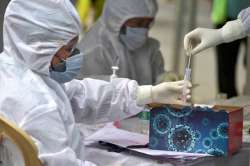Delhi's Wuhan: Parts of Jahangirpuri remain shut, even after 3 months
Jahangirpuri has been one of the earliest containment zones of the national capital and parts of it continue to remain so, even after nearly three months of the first lockdown. By April-end, nearly 100 were affected with COVID-19 and by now, at least 285 stand infected. But why has this area of North Delhi come to be known as the Wuhan of Delhi?

Jahangirpuri has been one of the earliest containment zones of the national capital and parts of it continue to remain so, even after nearly three months of the first lockdown. By April-end, nearly 100 were affected with COVID-19 and by now, at least 285 stand infected. But why has this area of North Delhi come to be known as the Wuhan of Delhi?
Officials cite population density -- most houses of Jahangirpuri are too small and multi-storey structures have come up in a space of 25 square yards where social distancing is an alien concept. Even after numerous government advertisements on precautions against Covid-19, it's practically unfeasible to practise social distancing where one small room is shared by many.
Another reason is said to be the failure of the residents to be mindful of the seriousness of the situation. For instance, a corona positive woman's cremation was attended by a crowd that did not care about the standard operating procedures. It led to infection of 31 people, 26 of them from one family.
It all started with just two blocks -- B and C where the corona virus first struck. Soon, the entire Jahangirpuri area came under the virus grip. In one lane alone in H Block, as many as 48 residents were tested positive for COVID-19. Compare and contrast it with the northeastern state of Meghalaya, where there are only only 18 active cases today.
Even as Delhi started to open up with restrictions giving way to free movements, the residents of Jahangirpuri have had no respite. A health official says hardly a fortnigt goes without a series of reported cases.
So grim has been the situation that Jagjivan Ram Hospital -- the main care centre around the vicinity -- was temporarily shut after the hospital itself became a containment zone. Around 60 employees of the hospitals have so far tested positive. Many of the employees live in Jahangirpuri itself. Contact tracing of them only exposed the seriousness of the situation. Though the hospital is back on its feet after sanitization, many are still afraid of a second wave of attack.
On March 22, ahead of the lockdown 1.0, B Block of Jahangirpuri was declared a containment zone. But nearly three months on, parts of Jahangirpuri are yet to be thrown open. Shopowners complain of inconvenience and allege the government is discriminating against them.
All shops of Jahangirpuri have been shut since the day Prime Minister Narednra Modi appealed to Indians to observe 'Junta Curfew'. While the economy is struggling to be back on track with hints of more curbs being lifted coming from the Prime Minister himself on Tuesday at the 6th PM-CMs video conference, Jahangirpuri remains a deep cause for worry.